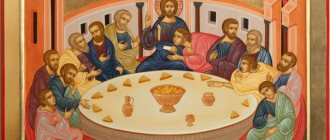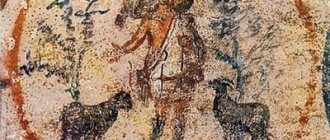B bible. When we hear this word, what analogies, ideas and parallels do we have?
We know that the Bible is a book, or rather, it is a collection of several books. The Bible is called "Scripture" or "Holy Scripture" and "the Word of God" - which is how it differs from other books. The Bible is God's message to humanity; He wanted to share with us information about Himself, about His Word, information about His creation. He wants to communicate with us and for this He created this Book. He has a Word to us.
John 1:1,2 says this:
“In the beginning was the Word, and the Word was with God, and the Word was God. It was in the beginning with God."
Let's take a quick look at the history, structure, and significance of this book.
History of the Bible
The Bible was written over fifteen centuries. It was written in letters, although early peoples used hieroglyphs and cuneiform for writing, i.e. depicted a story.
The Bible is divided into two parts: the Old (old) Testament and the New Testament (Gospel - “good news”). The books of the Old Testament were written in Hebrew, in the Phoenician alphabet, with capital consonants expressing the essence of the word. The books were written on scrolls made of tanned leather, using sharpened reeds and ink.
The words were not always separated from each other, much less there were chapters and verses. All books of the New Testament were written in ancient Greek. In 1228, Archbishop Stephen Langton created the chapter system, and in 1551, the Parisian Bible publisher Robert Etienne divided the chapters into verses.
The biblical text was written on three continents: Europe, Asia and Africa. About 45 people wrote the Bible. They had different origins, different status in society, and professions. Among them were: fishermen, military leaders, prophets, kings, shepherds, a tent maker, a doctor, a tax collector, etc. They differed from each other in culture, education, and abilities.
Of course, the author of the Bible is God Himself, but it was written by people under the influence of God’s Spirit, as we can read about in 2 Peter 1:19-21
“And moreover, we have a most sure prophetic word; and you do well to turn to him as to a lamp shining in a dark place, until the day dawns and the morning dawns in your hearts, knowing first of all this, that no prophecy in Scripture can be resolved (“created”). by yourself. For prophecy was never made by the will of man, but holy men of God spoke it, being moved by the Holy Spirit.”
God Himself, through His Spirit, gave His chosen people the ability to receive revelation from Him and, using their individuality, their style of expression, their language, spoke and wrote down His revelation to humanity through these people. But not only were the writers moved by the Spirit, the very text of Scripture breathes it, as we can see for ourselves by reading this book today.
Orthodox Life
Orthodoxy.Fm
The Bible is an amazing book, if only because for more than 2000 years it has been the work most in demand by mankind. Interest in the Holy Scripture does not fade away without any advertising and it does not leave any of its readers indifferent.
In today's TOP, we have collected 50 interesting facts about the Book of Books for our readers. We hope that you will find them not only entertaining, but also useful.
1. The Bible has no title
The word "Bible" comes from the ancient Greek "βύβλος" - "papyrus, book." The vast majority of books have the title: “Three Comrades”, “The Tale of Bygone Years”, “Odyssey”. But the Bible doesn't need a name. All people on earth simply say “book” and their interlocutors immediately understand that we are talking about the “Book of Books”.
2. Largest circulation
As of 2013, more than 6,000,000 Bibles or individual biblical books have already been published in the world, which is more than 6 times the number of copies of the next most popular publication. More than 32,500 new Bibles come out of the printing press around the world every day.
3. Engine of progress
Printing presses were invented and improved primarily for the purpose of publishing the Bible! In 1300, the cost of a handwritten book was equal to the cost of a castle. Publications printed in 1500 cost as much as a team of thoroughbred horses, and in 1700 they cost as much as a pair of good shoes. Finally, by 1900, the cost of the Bible reached the price of several dozen eggs and the Holy Scriptures became available to everyone.
4. “Collective of authors”
More than forty people worked on the texts of the Holy Scripture from the 15th century BC to the 1st century after the Nativity of Christ, that is, for 1600 years, many of whom did not even know each other. However, there are no obvious contradictions or inconsistencies in the Bible.
5. Translations
The Bible has been fully or partially translated into 2,377 languages and dialects, and has been fully published in 422 languages (according to the German Biblical Society at the beginning of 2005).
Even the blind can read the Holy Book in Braille in 84 languages, and audio versions of the Bible are available for illiterate and busy people.
6. "Collection of Fairy Tales"
Some people question the inspiration of Holy Scripture. However, the Bible is a book created by a huge number of authors who had extensive life experience in completely different areas, so a priori it cannot be a “Collection of stupid fairy tales.”
Among the biblical writers: kings (Solomon, David), shepherd (Amos), doctor (Luke), fishermen (Peter and John), prophets (Moses, Isaiah, Daniel), general (Joshua), artisan (Apostle Paul), official (Apostle Matthew), etc. Some of them were not Jews, but Greeks or even Roman citizens.
7. Mother of Enlightenment
Today, the proportion of literate and educated people among Christians is higher than among atheists and representatives of other faiths. For men, this share is 88% of the total number, and for women - 81%.
Often, previously unenlightened peoples received, along with Christianity, their own writing, literature and history and the associated sharp cultural upsurge, which was associated with the need to master literacy and receive a good education to read the Bible and understand their faith.
8. Prophecies
The texts of the Old Testament contain prophecies that were fulfilled hundreds of years later. There are also prophecies in the New Testament, and many of them have also already been fulfilled in history, which further indicates the inspiration of the Holy Scriptures.
9. Canonical and non-canonical books
The Bible consists of two large sections: the Old and New Testaments. The Old Testament contains 39 canonical, that is, books recognized by the Church, and the New Testament - 27. Another 11 books of the Old Testament are not included in the church canon, but are present in the Slavic Bible.
10. Chapters and verses
The Bible was divided into chapters by Canterbury Bishop Stephen Langton in the 13th century, and into verses in the 16th century by the French printer Robert Etienne, after which the Bible acquired its modern appearance and ease of citation (book: chapter: verse).
11. Urgently needed
According to law enforcement officials, the Bible is even stolen more often than other books...
12. Surprisingly accurate book
In 1947, the Qumran Bible scrolls, dating from the 1st century, were discovered. When comparing with Bibles of the 10th century, scientists discovered that for a thousand years the Bible did not undergo any major changes that would affect its content, while many other works changed noticeably over time when rewritten.
13. Grandfather of humanity
The oldest person described in the Bible is Methuselah, who was the great-great-great-great-great-grandson of the forefather Adam (8th generation). He died at the age of 969. But in those days, most people lived about 900 years... Later, “lawlessness increased” in humanity and the Lord shortened people’s lives to modern 80-120 years.
14. Words in the Bible
The words “Do not be afraid” appear in the Bible 365 times, the number of days in a year. The word "Christian" appears only 3 times. In the Hebrew text, the verb “Bara” - “To create from nothing” occurs three times: during the creation of the world, the creation of living beings (living souls) and the creation of man.
15. Comments and quotes
Holy Scripture is the most quoted and commented work in the world. Only in the Oxford Library and on the 1st Epistle of the Apostle John the Theologian alone are collected such a number of works that they occupy a room of 20 sq.m.
16. Reading time
It takes at least 38 hours to read the Old Testament and 11 hours to read the New Testament. That is, it is possible to read the entire Bible in at least 49 hours, provided that a person does not get tired.
17. Scottish curiosity
The Bible is not completely translated into Scots. However, there is a translation into Scots of the New Testament by William Lorimer. It is notable for the fact that Satan's speech is rendered in ordinary English.
18. Biblical names
The longest name found in the Bible is Mager-shelal-hash-baz. The Lord told the prophet Isaiah to name his son, born of a prophetess, by this name. It means “quick in spoil” and “quick in execution” (Isa. 8:3).
19. King and Prophet David
The creator of the Psalter, King David, was very loved by God. If only because after the name of Jesus Christ, his name is mentioned in biblical texts most often: 1118 times.
20. The smallest Bible
The smallest Bible (the New Testament) was printed at the end of the 19th century using the photomechanical reduction method. The resulting book was 1.9*1.6 cm in size and less than 1 cm thick. A small magnifying glass was inserted into the cover of each Bible to read the text.
21. Muslims
The founder of Islam, Muhammad, was familiar with the texts of the Holy Scriptures and used them when writing the Koran. Muslims revere the Old Testament forefathers and Jesus Christ, whom they consider one of the prophets.
22. Oath on the Bible
The American tradition of swearing on the Bible contradicts the text of the Holy Scripture: “Again you have heard that it was said to the ancients: Do not break your oath, but fulfill your oaths before the Lord. But I say to you: do not swear at all: not by heaven, for it is the throne of God; nor the earth, for it is His footstool; nor by Jerusalem, because it is the city of the great King; Do not swear by your head, because you cannot make a single hair white or black. But let your word be: yes, yes; no no; and anything beyond this is from the evil one” (Matthew 5:33-37).
23. The most expensive Bible
The most expensive Bible is considered to be the Bible of the German pioneer Johannes Gutenberg, published in 1456. Gutenberg printed 180 copies of the Bible, of which only 21 books have survived. Various copies of it are valued at $25-35,000,000.
Even more expensive was the Codex Sinaiticus, which belonged to the Russian imperial house and was sold by the Bolsheviks to Great Britain for $510,000,000.
24. Biblical kings
The longest reigning king in the Bible was King Manasseh, who was on the throne for 55 years (2 Kings 21:1). The least reigning king was Zimri, who wore the crown for only seven days (1 Kings 16:15).
25. Brothers and sisters of the Lord
The Gospel mentions the brothers and sisters of Jesus Christ. But these are not His brothers, but the sons and daughters of Joseph the Betrothed from his first marriage. Joseph himself was only the named husband of the Mother of God and kept her virginity all his life. And the Brothers of the Lord later became His apostles. One of them, James the Brother of the Lord, led the first Christian community in Jerusalem.
You can read the second part of “TOP 50 Interesting Facts about the Bible” here .
Selection by Andrey Szegeda
Orthodoxy.Fm
Structure of the Bible
The Bible has 66 books (canon): 39 books of the Old Testament (written between 1500-400 BC) and 27 books of the New Testament (written between 45-95 AD). There is no name “Old Testament” in Jewish literature; Jews call all Scripture Tanakh (Talmud - comments on the Tanakh).
The Tanach is divided into 3 parts:
a ) Law ( Torah ) – Genesis, Exodus, Leviticus, Numbers, Deuteronomy;
b ) Prophets ( Nebiim ) - the books of Joshua, Judges, 4 books of Kings, books of the later prophets (Isaiah, Jeremiah) and 12 books of minor prophets;
c ) Scriptures ( Ketubim and sacred scriptures ) - Psalms, Proverbs, Job, Song of Songs, Ruth, Lamentations, Ecclesiastes, Esther, Daniel, Ezra, Nehemiah and 2 Chronicles.
The books of the New Testament begin with the 4 Gospels, which describe the birth, life, ministry, death, resurrection, ascension of Jesus Christ and His teaching of disciples who were to continue His work after the ascension.
The book of Acts of the Apostles describes the emergence of the church on the Day of Pentecost and the beginning of the spread of the gospel message throughout the world through the ministry of the apostles.
Epistles (letters) are divided into general (conciliar) and epistles of the Apostle Paul (Shaul) - 14.
The New Testament ends with the book of the Revelation of John (Apocalypse), which contains a narrative of eschatological events.
Bible stories are any stories found in the Holy Scriptures
Biblical history is not an independent genre of work.
Moses in a Basket This is what we call any stories that the Holy Scripture gives us. The implication is that the stories in the Bible are there for a reason. The Holy Scripture consists only of those stories that can be useful for the human soul.
A fair question is, how historically reliable are the biblical accounts? Obviously not 100%. The text was written by people, and often much later than the events narrated. Something was forgotten, something was embellished. It's unavoidable.
The Bible is full of wise and instructive stories (Van Gogh, “Still Life with the Bible”). Photo: vangogen.ru
But the Bible is not a history book. The purpose of Bible stories is a moral and spiritual message. If you managed to reach a person’s heart, this is the most important thing.
The universality of Bible stories is remarkable. Each episode, parable or psalm can be applied to different situations. This makes the text of Holy Scripture universal and always relevant.
Biblical personalities are not always role models, but more often the opposite
We should not idealize biblical characters. The status of a patriarch or a prophet does not make a person ideal. Actually, from the biblical point of view, only God is impeccable. All others are sinners.
The Bible is not a roll of honor for spiritual persons. In it we most often see not an example of how to do it, but just the opposite - of how not to do it. Most biblical characters are examples of sins and mistakes.
Patriarch Jacob deceived his parents and deprived his brother of the privileges due to him. He behaved dishonestly and aggressively towards others. Rachel even reproached his wife for being barren.
King David is a seemingly pious ruler, hero, poet. But at the same time, he is a vile man who, for the sake of lust, doomed his subordinate to death.
Even though the king later repented, he couldn’t take back what he had done.
King Solomon is a seemingly wise man, but even his wisdom leads to conflict with God
The king betrays his own beliefs.
Almost every biblical character has skeletons in their closet: the cowardly Abraham, who gives his wife to the pharaoh, the cruel Moses with his bloody exterminations of neighboring peoples.
All this cannot be an example for a pious Orthodox Christian. We need to be able, as Christ said, to separate the wheat from the chaff. And in every story we must learn to see the essence, and not blindly idealize its characters.
By leaving a comment, you accept the user agreement
It is helpful to regularly read and ponder different Bible stories
Bible stories should be read thoughtfully. These are lessons from which different layers of meaning can be drawn. The richest in them, of course, are the clergy of Jesus Christ. These are sketches that can be interpreted on different planes.
Thus, we receive an inexhaustible source of information for comprehension. If it is difficult for us to learn something from a particular story, then there are always comments from the holy fathers and interpretations of researchers. They will help.
Why did God create man










